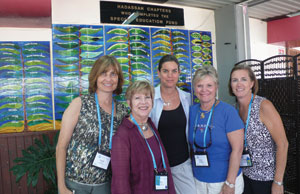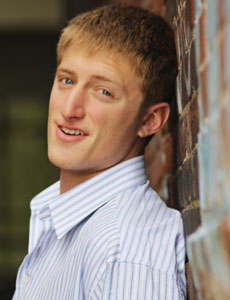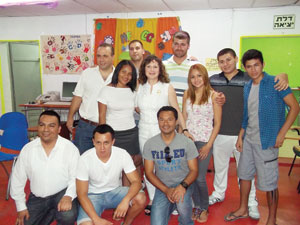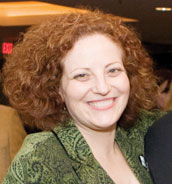Help us enhance Jewish life at home and worldwide
 Knowledge is quite empowering. And it is an especially powerful and at the same time humbling feeling to have the responsibility to carry that knowledge home in hopes of relaying information for the greater good.
Knowledge is quite empowering. And it is an especially powerful and at the same time humbling feeling to have the responsibility to carry that knowledge home in hopes of relaying information for the greater good.
Last month we had a unique opportunity to visit Odessa, Ukraine, and Israel. Joining us on this trip and helping us bring the message back to the Kansas City Jewish community were Beverly Jacobson, Women’s Division director, and Gail Weinberg, director of Financial Resource Development at the Jewish Federation. We were also joined in Odessa by Trudy Jacobson, president-elect of Women’s Division, and her husband, John. The mission was designed for campaign chairs and directors of The Jewish Federations of North America.
We are excited to inspire our community by way of the information we have learned, and the great work we have witnessed from this mission.
One of our partner agencies, the JDC, has excelled at accomplishing so many programs in the way of rescue, relief and revitalization of Jewish life. In Ukraine, from feeding the hungry and helping the unemployed to supporting families with special needs and funding Jewish education, the Joint Distribution Committee has helped create meaning for their Jewish identity. Now, they have hope for a brighter Jewish future for their children. We were fortunate to experience all of these levels of support on the CCD Mission.
During our three days in Odessa, we supplied staples to the elderly and learned about the needs of families at risk through the Hesed welfare services. We learned through translators that numerous individuals are just now finding their Jewish roots. We learned of the World ORT schools, which teach Jewish children about cutting-edge technology, right alongside their Jewish studies.
We experienced the new Jewish Cultural Center where renewed Jewish life comes alive each day. Holocaust survivors and Righteous Gentiles shared their historic journeys. Poignantly, at Odessa’s Holocaust Memorial, our afternoon was ushered in by a rain storm and ended after the Yizkor ceremony. It was an afternoon we will never forget.
In Israel, our partner agency JAFI opened our eyes to the work they do in Israel to ensure that any Jew who comes to Israel from anywhere in the world can receive help to feel at home, once they arrive in Israel. With this support in acclimating to life in a new country, our fellow Jews have a great opportunity to be productive members of Israel, ensuring a strong future for the entire state.
The programs that our Jewish Federation and its partner agencies conduct to instill a love for Israel among our young adults is quite exhilarating. A number of programs are in place for such a task. For those of you who know a Birthright Israel participant, you may have heard about the life-changing experiences they experienced during their 10-day trip. We got to experience it first-hand, meeting up with some Birthright participants during their trip. We visited with this group of young Jewish travelers as they expressed their appreciation for the opportunity to unite and experience Israel. They were traveling through Israel alongside Jews from all over the globe, and their energy was contagious. We left our visit with them with a sense of hope for resurgence in our collective interest for our Jewish homeland.
It feels great to help others; it feels great to see others become successful and have new purpose for a positive and fulfilling Jewish life.
Though many needs in Kansas City are being tended to by the Jewish Federation — which sustain and enhance our own lives in many ways — our fellow Jews around the world are still seeking help for a new lease on life.
The job is daunting.
The job is rewarding.
The job is always going to be challenging.
As campaign co-chairs, we are hopeful because Jewish life in Kansas City is quite unique. We are a community that has come together in so many wonderful ways. And we believe we can come together for the 2013 campaign and accomplish our goal. We want to grow Kansas City’s commitment to sustaining and enhancing Jewish life at home and around the world, and we ask you to help.
Our campaign committee would love additional participation in the coming year. We would be thrilled to speak with anyone who is interested in volunteering their time or their resources to further the cause of Jewish community.
Please call the Jewish Federation office if you would like to speak to any of us about our travels and about how you can make a huge difference in the lives of others. You can reach us at 913-327-8100, or visit us online to learn more at jewishkansascity.org.
Polly Kramer is co-chair of the Jewish Federation General Annual Campaign. Sandy Passer is co-chair of the Women’s Division Annual Campaign.



 Editor’s note: The following is an essay written by Jonathan Hermanson, the winner of the 2012 Margolis Scholarship Contest sponsored by B’nai B’rith’s Kansas City Lodge #184. Thirteen contestants competed for the $2,000 prize.
Editor’s note: The following is an essay written by Jonathan Hermanson, the winner of the 2012 Margolis Scholarship Contest sponsored by B’nai B’rith’s Kansas City Lodge #184. Thirteen contestants competed for the $2,000 prize. This past June, I had the opportunity to travel to Israel to attend the General Assembly and Board of Governors meetings of The Jewish Agency for Israel. As a representative of the Jewish Federation of Greater Kansas City, I have the honor to sit on the Jewish Agency board of governors, which brings together leaders from our devoted Jewish family from around the world to discuss and create solutions to address the biggest challenges facing our Jewish community here in Kansas City, in Israel and around the world. The Jewish Agency for Israel is a primary overseas partner of the Jewish Federations, and it was inspiring to see the commitment of representatives from Jewish Federations, religious movements and various other institutions which form the board of governors — a round table of the “Jewish collective.”
This past June, I had the opportunity to travel to Israel to attend the General Assembly and Board of Governors meetings of The Jewish Agency for Israel. As a representative of the Jewish Federation of Greater Kansas City, I have the honor to sit on the Jewish Agency board of governors, which brings together leaders from our devoted Jewish family from around the world to discuss and create solutions to address the biggest challenges facing our Jewish community here in Kansas City, in Israel and around the world. The Jewish Agency for Israel is a primary overseas partner of the Jewish Federations, and it was inspiring to see the commitment of representatives from Jewish Federations, religious movements and various other institutions which form the board of governors — a round table of the “Jewish collective.” There were probably no more than 150,000 Jews in the United States at the time of the Civil War. Many of them served in the armies of both the North and the South. Then, on Dec. 17, 1862, General Ulysses S. Grant issued an infamous order that expelled the Jews “as a class” from the territories over which he had military control. The supposed reason for the order was to eliminate smuggling and profiteering, which Grant, at the time, attributed to Jewish merchants. In fact one family involved in profiteering was the Macks, Jewish clothing manufacturers. The Macks were Jewish, and their partner was none other than General Grant’s father, Jesse.
There were probably no more than 150,000 Jews in the United States at the time of the Civil War. Many of them served in the armies of both the North and the South. Then, on Dec. 17, 1862, General Ulysses S. Grant issued an infamous order that expelled the Jews “as a class” from the territories over which he had military control. The supposed reason for the order was to eliminate smuggling and profiteering, which Grant, at the time, attributed to Jewish merchants. In fact one family involved in profiteering was the Macks, Jewish clothing manufacturers. The Macks were Jewish, and their partner was none other than General Grant’s father, Jesse. For more than 200 years the Missouri Constitution has protected the religious liberty of all Missourians whether in the majority or minority. It already provides all Missourians with the right to privately and voluntarily prayer in public schools, workplaces and other government settings. But in 2011 our legislature recklessly decided to play with these fundamental rights by passing Constitutional Amendment 2 which will appear on the Aug. 7 ballot innocuously called “Freedom to Pray in Public Places.” This misguided amendment should be rejected. It would undermine religious freedom by putting government in the business of religion and allowing majority faiths to impose their religious beliefs on the minority.
For more than 200 years the Missouri Constitution has protected the religious liberty of all Missourians whether in the majority or minority. It already provides all Missourians with the right to privately and voluntarily prayer in public schools, workplaces and other government settings. But in 2011 our legislature recklessly decided to play with these fundamental rights by passing Constitutional Amendment 2 which will appear on the Aug. 7 ballot innocuously called “Freedom to Pray in Public Places.” This misguided amendment should be rejected. It would undermine religious freedom by putting government in the business of religion and allowing majority faiths to impose their religious beliefs on the minority. “Tangles: A Story about Alzheimer’s, My Mother and Me,” by Sarah Leavitt. (Skyhorse Publishing 2012)
“Tangles: A Story about Alzheimer’s, My Mother and Me,” by Sarah Leavitt. (Skyhorse Publishing 2012)